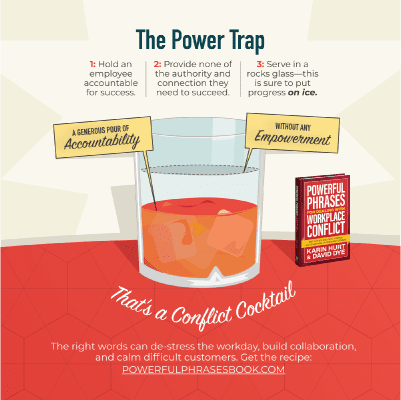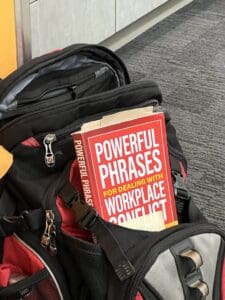Mistake at Work? How to Recover From a Big Fat Workplace Oops
You know that sinking feeling when you make a mistake at work, The “uh-oh, did I just…” moment.
Maybe you hit Reply All when you shouldn’t have. Or you gave the client last year’s numbers. Or—you discovered that the 200 mugs you ordered proudly proclaim your department as Pubic Relations.
Yep. We’ve all been there.
The question isn’t whether you’ll mess up. The question is: How are you going to recover?
The fastest way to make a bad situation worse is to pull out the ol’ Diaper Genie Strategy—you seal it up tight, twist, twist, twist, and hope nobody notices the smell. That works for actual diapers. It’s a disaster for workplace mistakes. Because if you can’t smell it, you can’t fix it.
So instead of covering up or blindsiding your boss, use this simple, sanity-saving framework: The D.A.R.N. Method.
The D.A.R.N. Method for Recovering from a Workplace Mistake (Watch Video for More)

D – Disclose
No jump-scares. Tell them before they hear it from their boss, a client, or worse… social media. Keep it simple: what happened, and the root cause. This builds trust.
A – Accountability
Own your part. Even if it wasn’t all you. You might say, “I should have been closer to this situation” or “I know how important this is, and I want to do everything I can to make it right.” No blaming. No excuses.
R – Response
Share what you’ve already done to address it. “I called the customer to apologize, updated the numbers, and let the social media team know in case this goes public.” You’re showing that you’re not just dropping a problem—you’re leading the solution.
N – Next Steps
Come in with a plan: “Here’s what I think we should do next…” This is your moment to prove you can turn a mess into momentum.
Why D.A.R.N. Works for Mistake Recovery
No one expects you to be perfect, but they do expect you to be honest, proactive, and committed to fixing things. This method checks all three boxes and keeps you from spiraling into panic.
Your “Oops” Survival FAQ
Q: What if I freeze and can’t find the words?
Lead with disclosure. Even, “I need to bring you up to speed on something that just happened” buys you a moment to breathe.
Q: What if my boss gets mad?
Let them. Then listen. Try, “I know you’re frustrated. I am too and I’m sorry. That’s why I’m so focused on making this better and preventing it from happening again.”
See Also: Powerful Phrases to Deal with a Moody Boss (Even a Dropper of F-Bombs
Q: Can’t I just email them?
If there’s any chance the issue will make them look bad, talk in person (or on video) first. Follow up with an email summarizing facts and next steps so there’s a record.
Q: What if it wasn’t my fault?
Focus on fixing first, context later. Stepping up—even when it’s not “yours”—shows leadership.
Q: What are some “accountability phrases” that don’t make me a scapegoat?
You can own your part without turning yourself into the office punching bag. The key is to acknowledge your role while keeping the focus on solving the problem, not assigning lifelong blame. Try these:
-
“Looking back, I can see where I could have caught this earlier.”
-
“Here’s what I’m doing to make sure this doesn’t happen again.”
-
“I was responsible for X, and here’s how I’m addressing it.”
-
“I see the impact this has had, and I want to help fix it.”
-
“I own my part of this, and I’m committed to getting us back on track.”
Notice what’s missing?
Phrases like “This is all my fault” or “I completely messed everything up”—because that invites people to pile on and doesn’t actually move the solution forward.
Q: What are some “next step” phrases that make me sound proactive instead of defensive?
You want to sound like you’re already steering the ship back on course, not floating helplessly in the water. Here are some ways to frame it:
-
“My immediate next step is…”
-
“I’d like to run this plan by you before moving forward.”
-
“Here’s how we can prevent this in the future…”
-
“I’ve identified two possible fixes—here’s the pros and cons of each.”
-
“Let’s agree on the next milestone so we can check progress.”
 These phrases keep the focus forward, invite collaboration, and signal that you’re not waiting to be rescued.
These phrases keep the focus forward, invite collaboration, and signal that you’re not waiting to be rescued.
Mistakes happen. Your career isn’t defined by the ones you make—it’s defined by how you handle them. So ditch the diaper genie, D.A.R.N. it, and turn your worst “uh-oh” moments into trust-building wins.
Learn more about our book Powerful Phrases For Dealing wih Workplace Conflict in this short video.






Hello. I received this newsletter from a colleague and I would like to sign up to receive the newsletter.
Hi Pamela, Great! We will subscribe you!